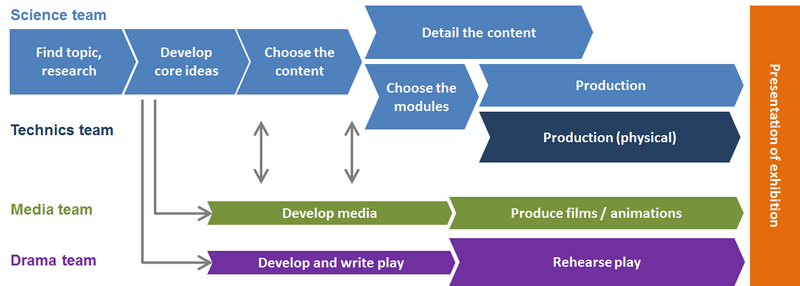Conception and realization of the exhibition at school
The realization and the installation of the exhibition is a joint project of different course offers, it is particularly planned in the (free choice) afternoon classes. Due to the distribution to different groups, there is the possibility to integrate the pupils according their likings and capabilities. At the end, it will be possible to present a real joint project. Due to the diversity of the scope for design of an exhibition, it is possible to realize the concept at almost each school, determined by the available course offers at school.
The integration in a subject is possible but also the realization in the frame of a seminar of compulsory subject choice (e.g. praxis of the natural sciences). In the following, there will be a short exemplary description of the assignment of tasks in such a project.

The content is the central subject of an exhibition. This will be developed by a bigger group of pupils from a natural scientific profile / of a natural scientific course, the science team. The main task is of curatorial type, which means to review that topic in his width, to develop the main topics for the exhibition and to check them concerning presentation possibilities. The contact to local research groups, e. g. of the University allows insight into real research, a visit of a museum gives inspiration for the presentation in such context. The team will be supported by pupil’s works concerning unique subjects, which are analyzing in detail punctual aspects (e.g. in Bavaria, there are so called W- or P-courses, were students work on a topic over a whole year and then write a final report, or an annual work at a Freie Waldorfschule). The visual presentation of the contents will be developed by further working groups in close agreement with the science team. The design team (e. g. from an artistic profile) develops and produces a suitable graphic layout for the exhibition, the media team creates medial contents as interviews with scientists, animations or perhaps a short game.
A technics team supports the realization of experiments and equips the exhibition with light and media. A drama team (e. g. from a linguistic profile or course) writes and rehearses a play, which will be performed during the exhibition. A rhetoric team trains, together with the science team, so-called “Explainers”, pupils, who will guide visitors and explain the content correctly and easy to understand.
All these contents will be integrated in the available module concept (see category construction manuals) in order to present a well organized exhibition.



